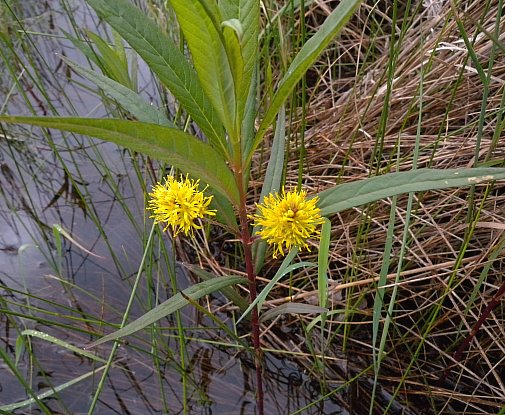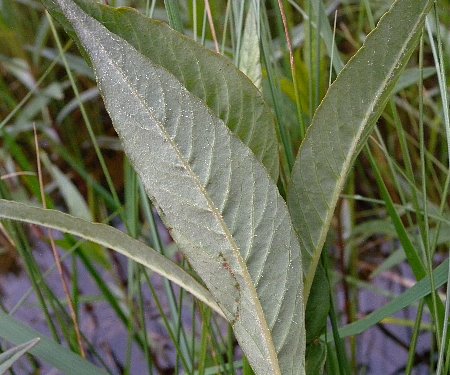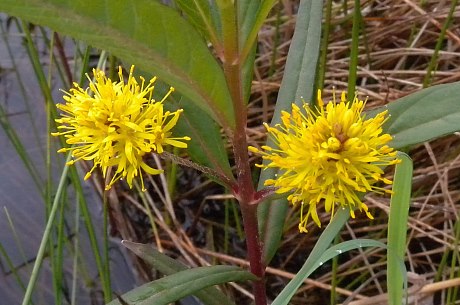
Short dense racemes of flowers about 1-1½" long and 1" across are produced from the axils of the middle leaves on peduncles about ½-2" long. Individual flowers are about 1/3" (8 mm.) across, consisting of a pale yellow to yellow corolla with 5-7 lobes, a pale green to yellow calyx with 5-7 lobes, 5-7 exerted stamens, and a pistil with an exerted style. Both the corolla and calyx are deeply divided into linear-elliptic lobes that are widely spreading; the corolla is about twice the length of the calyx. The peduncles are light green to purplish red and usually hairy. The pedicels of the flowers are up to 1/8" (3 mm.) long. Dark glandular dots may be visible on the flowers, stems, and leaves. The blooming period occurs from late spring to mid-summer for about 3-5 weeks. Fertile flowers are replaced by small seed capsules about 1/8" (3 mm.) across. Individual capsules contain relatively few triangular seeds, which are eventually released to the wind or water. The shallow root system is rhizomatous. Occasionally, clonal offsets are formed from the rhizomes.
Cultivation: The preference is full or partial sun, wet to consistently moist conditions, soil containing sandy or peaty material, and summer temperatures that are not excessively hot.

Range & Habitat: The native Tufted Loosestrife is occasional in NE Illinois and parts of central Illinois, otherwise it is rare or absent (see Distribution Map). In addition to North America, this circumboreal species also occurs in Eurasia. Habitats include openings in floodplain woodlands, swamps, sandy marshes, bogs, and soggy meadows along streams or ponds. Tufted Loosestrife is found in higher quality wetlands.
Faunal Associations: The flowers of Lysimachia spp. are cross-pollinated by bees in the Melittid family. In Illinois, Macropis steironematis is the most typical visitor of the flowers, where it collects both floral oil and pollen. Sometimes small Halictid bees collect pollen as well. The caterpillars of Papaipema lysimachiae (Loosestrife Borer Moth) bore through the stems of Tufted Loosestrife and other Lysimachia spp. Information about this wildflower's interrelationships with vertebrate wildlife is currently unavailable.

Photographic Location: A sandy marsh in Lucas County, NW Ohio.
Comments: Mohlenbrock (2009) uses the scientific name, Naumbergia thyrsiflora, to refer to this species. This is a monotypic genus. Because of its ball-like clusters of flowers with exerted stamens, Tufted Loosestrife is easily identified when it is in bloom. Other Lysimachia spp. produce larger flowers that are more separated from each other. In spite of the similarity in their common names, this group of plants should not be confused with Lythrum alatum (Winged Loosestrife), Lythrum salicaria (Purple Loosestrife) and other species in the Loosestrife family (Lythraceae).